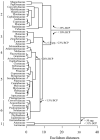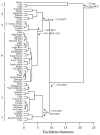Plant Natural Sources of the Endocannabinoid (E)-β-Caryophyllene: A Systematic Quantitative Analysis of Published Literature
- PMID: 32906779
- PMCID: PMC7554841
- DOI: 10.3390/ijms21186540
Plant Natural Sources of the Endocannabinoid (E)-β-Caryophyllene: A Systematic Quantitative Analysis of Published Literature
Abstract
(E)-β-caryophyllene (BCP) is a natural sesquiterpene hydrocarbon present in hundreds of plant species. BCP possesses several important pharmacological activities, ranging from pain treatment to neurological and metabolic disorders. These are mainly due to its ability to interact with the cannabinoid receptor 2 (CB2) and the complete lack of interaction with the brain CB1. A systematic analysis of plant species with essential oils containing a BCP percentage > 10% provided almost 300 entries with species belonging to 51 families. The essential oils were found to be extracted from 13 plant parts and samples originated from 56 countries worldwide. Statistical analyses included the evaluation of variability in BCP% and yield% as well as the statistical linkage between families, plant parts and countries of origin by cluster analysis. Identified species were also grouped according to their presence in the Belfrit list. The survey evidences the importance of essential oil yield evaluation in support of the chemical analysis. The results provide a comprehensive picture of the species with the highest BCP and yield percentages.
Keywords: Belfrit list; essential oil; geographical origin; percentages of (E)-β-caryophyllene; plant part; plant species; yield.
Conflict of interest statement
The author declares no conflict of interest.
Figures





Similar articles
-
A focused review on CB2 receptor-selective pharmacological properties and therapeutic potential of β-caryophyllene, a dietary cannabinoid.Biomed Pharmacother. 2021 Aug;140:111639. doi: 10.1016/j.biopha.2021.111639. Epub 2021 Jun 3. Biomed Pharmacother. 2021. PMID: 34091179 Review.
-
Protective Effects of (E)-β-Caryophyllene (BCP) in Chronic Inflammation.Nutrients. 2020 Oct 26;12(11):3273. doi: 10.3390/nu12113273. Nutrients. 2020. PMID: 33114564 Free PMC article. Review.
-
Beta-caryophyllene is a dietary cannabinoid.Proc Natl Acad Sci U S A. 2008 Jul 1;105(26):9099-104. doi: 10.1073/pnas.0803601105. Epub 2008 Jun 23. Proc Natl Acad Sci U S A. 2008. PMID: 18574142 Free PMC article.
-
β-caryophyllene and β-caryophyllene oxide-natural compounds of anticancer and analgesic properties.Cancer Med. 2016 Oct;5(10):3007-3017. doi: 10.1002/cam4.816. Epub 2016 Sep 30. Cancer Med. 2016. PMID: 27696789 Free PMC article. Review.
-
Plant-Derived Trans-β-Caryophyllene Boosts Glucose Metabolism and ATP Synthesis in Skeletal Muscle Cells through Cannabinoid Type 2 Receptor Stimulation.Nutrients. 2021 Mar 12;13(3):916. doi: 10.3390/nu13030916. Nutrients. 2021. PMID: 33809114 Free PMC article.
Cited by
-
β-Caryophyllene Inhibits Oxaliplatin-Induced Peripheral Neuropathy in Mice: Role of Cannabinoid Type 2 Receptors, Oxidative Stress and Neuroinflammation.Antioxidants (Basel). 2023 Oct 22;12(10):1893. doi: 10.3390/antiox12101893. Antioxidants (Basel). 2023. PMID: 37891972 Free PMC article.
-
Beta-Caryophyllene Modifies Intracellular Lipid Composition in a Cell Model of Hepatic Steatosis by Acting through CB2 and PPAR Receptors.Int J Mol Sci. 2023 Mar 23;24(7):6060. doi: 10.3390/ijms24076060. Int J Mol Sci. 2023. PMID: 37047034 Free PMC article.
-
Fibromyalgia: Recent Advances in Diagnosis, Classification, Pharmacotherapy and Alternative Remedies.Int J Mol Sci. 2020 Oct 23;21(21):7877. doi: 10.3390/ijms21217877. Int J Mol Sci. 2020. PMID: 33114203 Free PMC article. Review.
-
Plant-Based Bioactive Molecules in Improving Health and Preventing Lifestyle Diseases.Int J Mol Sci. 2021 Mar 15;22(6):2991. doi: 10.3390/ijms22062991. Int J Mol Sci. 2021. PMID: 33804225 Free PMC article.
-
Consumption of β-Caryophyllene Increases the Mating Success of Bactrocera zonata Males (Diptera: Tephritidae).Insects. 2024 Apr 26;15(5):310. doi: 10.3390/insects15050310. Insects. 2024. PMID: 38786866 Free PMC article.
References
-
- Francomano F., Caruso A., Barbarossa A., Fazio A., La Torre C., Ceramella J., Mallamaci R., Saturnino C., Iacopetta D., Sinicropi M.S. Beta-caryophyllene: A sesquiterpene with countless biological properties. Appl. Sci. 2019;9:9–19. doi: 10.3390/app9245420. - DOI

